- Home
- Terry Pratchett
The Folklore of Discworld Page 9
The Folklore of Discworld Read online
Page 9
There was once a Norwegian troll who tried a different plan. Hearing that St Olaf was trying to build himself a church at Trondheim, he volunteered his services as a stonemason. But this was in fact a plot to kill Olaf. ‘I’ll build your church for you,’ said the troll, ‘but I’ll take the sun and the moon and the heart out of your breast as my fee – unless you can guess my name before the last stone is in place.’ The troll turned out to be not only extremely strong but also a remarkably quick worker, and in no time the walls were done, and the tower was rising fast. But then one night as the saint wandered gloomily along the mountain paths, he heard the voice of a she-troll from inside the rocks, as she sang her little ones to sleep: ‘Hushabye, hushabye, your daddy Finn will soon be home, and he’ll bring you the sun and the moon to play with, and the priest’s heart too.’ Next morning St Olaf strolled up to the church, just as the troll was setting the last course of stones on the tower. ‘Splendid work, Finn,’ said Olaf. Now, it is one of the basic rules of folklore that to know a magical creature’s name gives you the power to destroy him – and another, that somehow or other the secret is sure to get out. So the troll crashed down dead, but Trondheim cathedral is still there.
The physiology of Earth’s mountain trolls must be based on silicon, like that of their Discworld counterparts, judging by the way they all too easily turn into large boulders, which in their case are permanent. One variety, the Icelandic Night-troll, hides in caves all day and only comes out at night, because any ray of direct sunlight petrifies it at once. There are several spectacularly tall rocks offshore which are said to be trolls caught unawares by the sunrise while wading out to sea.
Naturally, the best defence against a Night-troll is to keep it talking till the sun comes up. There was once an Icelandic girl who had been left at home on Christmas Eve, to look after her baby brother while everyone else went to church. In the middle of the night she heard a deep voice outside the window, serenading her.
Fair seems your hand to me,
Hard and rough mine must be,
Dilly-dilly-do.
But she did not look round. Instead, she sang to the baby in the cradle:
Dirt it did never sweep,
Sleep, little Kari, sleep,
Lully-lully-lo.
When the troll praised her eyes and her feet, she told the baby that she had never looked on anything evil, never trodden on dirt. And so it went on all night, till dawn broke and the girl sang in triumph:
Stand there and turn to stone,
So you’ll do harm to none,
Lully-lully-lo.
And when the family came home from church, they found a huge boulder on the path between the farm buildings, which had certainly not been there the night before.
As this tale shows, one difference between the way trolls evolved on Earth and in the Discworld is that the Earth ones can get amorous towards humans, an idea which would never enter the head of a troll on the Disc. Icelandic she-trolls sometimes kidnap a handsome young man to be their mate, or lure him up into their caves by magic chants. There, they do all they can to seduce him, and to persuade him to eat trolls’ food; they rub him with strange ointments, stretch his limbs, and bellow into his ear, to make a troll of him. It is said that men who do not manage to escape gradually do turn into trolls themselves. In the Norwegian legend of Peer Gynt, the King of the Mountain wanted Peer to marry his daughter, who was apparently quite good-looking, whereas it is unlikely that a female Discworld troll would ever appeal to a male human, no matter how cheap the beer and however bad the club lighting.
Earthly trolls can, in fact, look like humans and humans can become trolls, and it has been suggested that trolls have their origins in ‘folk memories’ of earlier races (even Neanderthals) who were pushed to the edges of the habitable world by the stumbling advance of civilization, and then into myth and story. This attractive and beguiling idea is very familiar to folklorists as an explanation for ‘fairy’ folk of any sort (who look outlandish and have strange powers), and so we will back tactfully away and leave it to the anthropologists.
It’s worth adding that Discworld trolls cannot digest human beings (though they have been known to try), whereas those of Earth find them both tasty and wholesome. In Norway, men have heard she-trolls bellowing to one another among the crags, discussing their cooking: ‘Sister, can I borrow your big pot?’ – ‘What for?’ – ‘Here’s Jon the woodcutter coming up this way, I want to make a stew of him.’ – ‘All right, Sister. When you skim the broth, save some of the fat for me.’ Somehow, bellowing across the landscape that you are waiting in ambush seems so very troll.
Trolls were still being talked about in Iceland as late as the nineteenth century. There were certain cliffs where seabirds nested, and it was said that when men went over the edge on ropes to gather eggs or to catch the birds themselves for food, great, grey, shaggy hands carrying very sharp knives would reach out from caves and cut the ropes, and so kill the men who hung there. So then some priest would be sent for to drive the trolls out by going down on a rope and blessing the cliff, while men on the cliff-top sang psalms as loud as they could. The really intelligent priests would bring a hammer, and chip away the sharp ridges on the cliff face as they blessed it – after which, the ropes hardly ever frayed and broke. But there remain a few cliffs which were never blessed, and where egg-gatherers never go, however many birds there may be. This is because once, when a bishop had gone down on a rope and was working his way along the cliff face, a voice from inside the rocks called out: ‘Don’t bless anything more! The wicked do have to have somewhere to live!’ And the bishop, being a fair-minded man, left this place unblessed.
GARGOYLES
Although gargoyles are very different from a standard troll in size, appearance, habitat and habits, they are in fact a subspecies which has evolved to fit an urban environment. They are, if anything, even more stony; they squat motionless on some rooftop, which they are very reluctant to leave. On the other hand, their digestive system is quite different from that of trolls; they are carnivores, preying on pigeons. Their main occupation is absorbing rainwater from the gutters and ejecting it vigorously, through their gaping jaws, on to the heads of pedestrians below. When they do move, it is in slow, grinding jerks; their mouths are permanently fixed open, making it hard to understand their speech. But their endless patience and keen eyesight make them valuable members of the Watch in Ankh-Morpork, somewhat like CCTV cameras in a modern city on Earth.
Gargoyles are also a familiar sight on the roofs of Earth’s medieval churches and castles, where they got their name. It suits them well, for they gurgle, gargle and glug in their gullets, and most of them goggle too. But there are few, if any, stories about them, probably because they are too high up for anyone to see them properly.
SEA-TROLLS
It should be mentioned that ‘trolls’ of one sort or another apparently exist elsewhere in the multiverse. The wizard Rincewind, in one of his early adventures described in The Colour of Magic, was almost swept over the Edge of the Disc, where an endless cascade of ocean pours away into space. Instead, he crashed into the Circumfence – a single rope, suspended a few feet above the water from occasional wooden posts, and extending for tens of thousands of miles round the rim of the Disc. This particular section was patrolled by a sea-troll, a creature of a pleasantly translucent blue colour, apparently composed of sea-water and very little else. As for size, he gradually swelled as the hours went by, then just as gradually shrank; owing to the strength of the Discworld moon, he was suffering from chronic tides.
The sea-troll was not native to the Discworld. He came from a different disc, quite a small one (mostly blue), where the seafolk lived in thriving civilized communities on its three oceans. Unfortunately, he had been blown over the edge in a great storm, fell through outer space (which froze him solid), and eventually landed on the Disc. Curiously, the name of his own world is Bathys, which on Earth is Greek for ‘ocean depths’, and the troll’s
personal name is Tethis, remarkably close to that of the Ancient Greek sea-nymph Thetis.
Interestingly, the Norwegian artist Theodor Kittelsen, who painted a large number of what we now call fantasy paintings, did several based on trolls, including, in 1887, a fearsome sea-troll. Alas, it is not transparent.
Chapter 6
OTHER SIGNIFICANT
RACES
VAMPIRES
THE CHILDREN OF THE NIGHT are an increasing presence in Ankh-Morpork these days, thanks to the efforts of the Uberwald League of Temperance. Sensible vampires have realized that a diet of black pudding and blood sausage and a stake in a growing economy is much to be preferred to just a stake. However, it was not always thus: the vampire – or at least the image of the vampire – has evolved quite markedly over the centuries.
Do vampires suck blood? Silly question, nowadays. If there’s one thing everybody knows about vampires, it’s that they suck your blood, leaving you with two neat puncture marks at the base of your neck. Of course, what everyone knows is wrong, and nearly everyone knows it. At least, we think so; the trouble with what everyone knows is that you can never be sure that everyone knows it. But surely everyone knows that vampires, like werewolves, have stepped out of folklore and into popular culture. The movies, of course, were the major influence; in the 1950s and 60s a generation grew up (thanks to Hammer Films) knowing that female vampires always wore underwired nightgowns, and male ones a high-collared black cloak with a red satin lining.6
But it was not always so. In the folklore of the Balkans, Greece, and Central Europe a vampire, also known as a nosferatu, a vrykolakas, or a nachzehrer, was simply an Undead revenant – a corpse that gets out of its grave and wanders about. Some sucked blood, others didn’t. Instead, they might breathe on you and give you plague, cholera or consumption; or sit on your chest and give you nightmares; or strangle you; or beat you black and blue; or simply get into your house and smash the furniture. Subtle and elegant they were not. Their close relative, the draug of medieval Iceland, would break every bone of your body, and of your cattle too.
Early European vampires were not aristocrats, but village folk. They did not look like noble gentlemen in black cloaks, or luscious women in low-cut ball gowns. They looked like what they were, corpses. To be precise, corpses that have been buried long enough to begin decaying, but not long enough to turn into nice clean skeletons. When terrified locals dug into the grave of a suspected vampire to destroy him, they would find a body bloated with gases, and therefore plumper and bigger than when alive; the skin taut; the blood no longer congealed, but runny, and often oozing from the mouth or nose; the face puffy and red, or in some cases dusky. If they jabbed a stake or spade into it, nasty reddish liquids gushed out. They might even hear a sort of grunt or squawk as the blow forced the gases out through the windpipe. Who could doubt that this was an Undead?
Such a corpse must then be destroyed by burning. If this is too difficult (dead bodies take a lot of burning), at least it can be mutilated or pinned down in some way, so that it will never walk again. Which is where staking comes in, or beheading, or tearing the heart out.
Vampires as the Earth knows them now are rather different. They were created by English writers in the Romantic and Victorian periods, and perfected by that most powerful myth-making medium, the cinema. The first was Lord Ruthven in John Polidori’s story ‘The Vampyre’ (1819), an evil blood-sucking deathless aristocrat. Then in 1872 came Joseph Sheridan Le Fanu’s story about the beautiful young Carmilla, who (like Salacia in Thud! ) assumed she could evade discovery by making anagrams of her name – Millarca, Mircalla. She was gentler than Lord Ruthven, but she too brought death; she was eventually found in a blood-filled coffin, staked, and decapitated.
And then, in 1897, Bram Stoker’s Dracula appeared, presenting the sinister but elegantly seductive Count, his female victims, and three erotic female vampires. Stoker stole the Count’s name from the real-life Vlad Dracul, also known as Vlad Tepes the Impaler, one of the great warrior-princes of Romanian history, who in his native country is respectfully remembered as a hero, and is never, never thought of as a vampire. Stoker also adopted many details from East European folklore. For over a hundred years now, the Dracula figure and its variants have been fixed in modern popular mythology – fangs, swirling black cloaks with red linings, brocaded waistcoats, a haughty manner, and an escort of bats, rats, and wolves.
On Discworld, the Count de Magpyr is a magnificent example of the aristocratic vampire, sprung from an ancient family whose motto is Carpe Jugulum, ‘Go for the Jugular’. His son Vlad is very much the dandy; his daughter Lacrimosa is a thin girl in a white dress, with very long black hair and far too much eye make-up. Their home is a castle on a crag in Uberwald, complete with sinister ancestral portraits. One of these shows Aunt Carmilla, a far more savage figure than Le Fanu’s heroine of the same name; she used to bathe in the blood of up to two hundred virgins at a time, just as the real-life Hungarian Countess Elizabeth Bathory was rumoured to do. It was a good cosmetic. There is also the portrait of the old Count de Magpyr (father of the present one, and remembered by some as ‘Old Red Eyes’):
A bald head. Dark-rimmed, staring eyes. Two teeth like needles, two ears like batwings, fingernails that hadn’t been trimmed for years …
That’s something known on this world too. That’s Nosferatu, perhaps the most terrifying vampire in the history of the cinema, as created in 1922.
But the current Count de Magpyr is adapting to modern times. To the fury of his servant Igor, whose attitude can be described as more-gothic-than-thou, he and his family wear full evening dress in the evenings only, not all the time, as his father the old Count did; the rest of the time, it’s fancy waistcoats for the men and lacy skirts for the women. In the castle, squeaky door-hinges must now be oiled, guttering candles removed, spiders chased out of the dungeons. There must be no black plumes on the coach or its horses – coaches looking like hearses are not at all cool.
The Count’s aim is to train his family, little by little, to overcome all the taboos which limit a vampire’s freedom, and which are only cultural conditioning – a conditioning which, strangely, seems to be much the same on the Discworld and the Earth. He believes that with a little effort and practice, modern vampires could and should learn to drink … wine, go out in sunlight, cross running water, eat garlic-flavoured canapés, bear the touch of holy water, and look at any sacred symbol without wincing. By and large, the plan seems to be succeeding. But they still can’t enter a house unless invited.
As was noted above, quite a number of Discworld vampires hope to become integrated into society as a whole, and so have joined the Uberwald League of Temperance; members have forsworn the drinking of human blood – or, as they prefer to call it, ‘the b-word’. They carry their badge, a small twist of shiny black ribbon, and gather regularly in mutual support groups for a nice singsong with cocoa and a bun. One Black Ribboner is Otto Chriek, a brilliant iconographer on the staff of the Ankh-Morpork Times. He dresses as the cinematic stereotype requires, and speaks (when he wants to) with a thick Uberwald accent – deliberately so, to make people laugh. That way, no one fears him, or hates him. Since Otto personally has not overcome his hereditary allergy to strong light, he suffers intensely whenever he has to use a flash, sometimes even crumbling to dust. He carries a card for such emergencies:
DO NOT BE ALARMED. The former bearer of this card has suffered a minor accident. You vill need a drop of blood from any species, and a dustpan and brush. [The Truth]
If some kind person dribbles a drop or two from, say, a piece of raw steak on to the dust, it mushrooms up into the air, becomes a mass of coloured flecks, and once again is Otto Chriek.
From the information so far available, it looks as if all Discworld vampires become such either by their genetics, or by being bitten. Admittedly, one may suspect that the genes of the late Count Notfaroutoe were pretty reluctant to be activated in the unlikely DNA of his only remaining
relative, his nephew Arthur Winkings, who was a coming man in the wholesale fruit and vegetable business. And Arthur was even more reluctant to receive them, as we learn in Reaper Man. But that’s how it goes – if you inherit the title and the estates, you get the coffin and the batwings too. Genetics, or a bite. Take your choice.
On the Earth, this is true in the literary and cinematic mythology, but in European folklore there are plenty of other reasons why the dead become vampires. They may have lived an evil life, committed suicide, or practised black magic; they may have been conceived in sacrilege, their parents having had sex on a holy day; they may have been born with teeth, or a tail, or two hearts,7 or a caul. In Romania, anyone with red hair and blue eyes is regarded as a potential vampire. In many parts of Europe, a corpse will become a revenant if it is left unburied, or buried secretly without proper rites. If it is laid out at home, it should be in a lighted room, and there should always be somebody keeping watch; no dog or cat should be allowed to jump on to or over it. Break any of these rules, and you will soon have a vampire in the village.
And when you do, what do you do about it? As the Quite Reverend Oats, self-appointed Omnian missionary to Lancre, explained to Nanny Ogg,
‘It depends exactly where they’re from, I remember. Uberwald is a very big place. Er, cutting off the head and staking them in the heart is generally efficacious … in Splintz they die if you put a coin in their mouth and cut their head off … in Klotz they die if you stick a lemon in their mouth – after you cut their head off. I believe that in Glitz you have to fill their mouth with salt, hammer a carrot into both ears, and then cut off their head … And in the valley of the Ah they believe it’s best to cut off the head and boil it in vinegar … But in Kashncari they say you should cut off their toes and drive a nail through their neck.’

 Feet of Clay
Feet of Clay The Color of Magic
The Color of Magic Thud!
Thud! Good Omens: The Nice and Accurate Prophecies of Agnes Nutter, Witch
Good Omens: The Nice and Accurate Prophecies of Agnes Nutter, Witch I Shall Wear Midnight
I Shall Wear Midnight Mort
Mort Raising Steam
Raising Steam Guards! Guards!
Guards! Guards!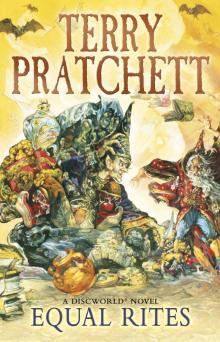 Equal Rites
Equal Rites A Hat Full of Sky
A Hat Full of Sky The Light Fantastic
The Light Fantastic Mrs Bradshaw's Handbook
Mrs Bradshaw's Handbook Wyrd Sisters
Wyrd Sisters Soul Music
Soul Music Small Gods
Small Gods Sourcery
Sourcery Reaper Man
Reaper Man Night Watch
Night Watch Lords and Ladies
Lords and Ladies The Fifth Elephant
The Fifth Elephant Monstrous Regiment
Monstrous Regiment The Truth
The Truth Witches Abroad
Witches Abroad Eric
Eric Going Postal
Going Postal Men at Arms
Men at Arms Jingo
Jingo The Amazing Maurice and His Educated Rodents
The Amazing Maurice and His Educated Rodents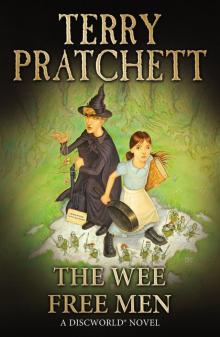 The Wee Free Men
The Wee Free Men Pyramids
Pyramids Wintersmith
Wintersmith Moving Pictures
Moving Pictures Carpe Jugulum
Carpe Jugulum Interesting Times
Interesting Times Maskerade
Maskerade Making Money
Making Money The Shepherd's Crown
The Shepherd's Crown Hogfather
Hogfather Troll Bridge
Troll Bridge The Last Continent
The Last Continent The Sea and Little Fishes
The Sea and Little Fishes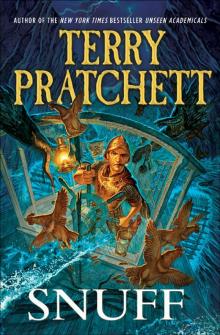 Snuff
Snuff Unseen Academicals
Unseen Academicals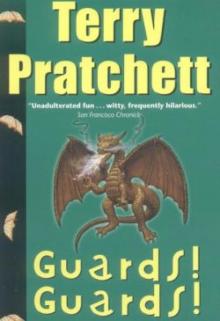 Guards! Guards! tds-8
Guards! Guards! tds-8 Jingo d-21
Jingo d-21 Turtle Recall: The Discworld Companion ... So Far
Turtle Recall: The Discworld Companion ... So Far The Fifth Elephant d-24
The Fifth Elephant d-24 Discworld 39 - Snuff
Discworld 39 - Snuff The Long War
The Long War Only You Can Save Mankind
Only You Can Save Mankind The Science of Discworld III - Darwin's Watch tsod-3
The Science of Discworld III - Darwin's Watch tsod-3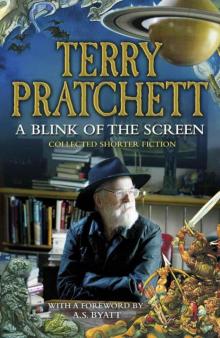 A Blink of the Screen: Collected Short Fiction
A Blink of the Screen: Collected Short Fiction Unseen Academicals d-37
Unseen Academicals d-37 Wings
Wings Making Money d-36
Making Money d-36 A Blink of the Screen
A Blink of the Screen Johnny and the Bomb
Johnny and the Bomb Dodger
Dodger Strata
Strata Discworld 02 - The Light Fantastic
Discworld 02 - The Light Fantastic The Folklore of Discworld
The Folklore of Discworld The Science of Discworld
The Science of Discworld The Unadulterated Cat
The Unadulterated Cat Raising Steam: (Discworld novel 40) (Discworld Novels)
Raising Steam: (Discworld novel 40) (Discworld Novels) The World of Poo
The World of Poo Discworld 05 - Sourcery
Discworld 05 - Sourcery The Witch's Vacuum Cleaner: And Other Stories
The Witch's Vacuum Cleaner: And Other Stories The Science of Discworld II - The Globe tsod-2
The Science of Discworld II - The Globe tsod-2 Small Gods: Discworld Novel, A
Small Gods: Discworld Novel, A Men at Arms tds-15
Men at Arms tds-15 Tama Princes of Mercury
Tama Princes of Mercury The Last Hero (the discworld series)
The Last Hero (the discworld series) The Long Utopia
The Long Utopia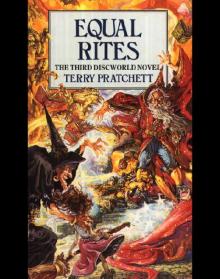 Discworld 03 - Equal Rites
Discworld 03 - Equal Rites Terry Pratchett - The Science of Discworld
Terry Pratchett - The Science of Discworld The Long Earth
The Long Earth The Carpet People
The Carpet People The Sea and Little Fishes (discworld)
The Sea and Little Fishes (discworld)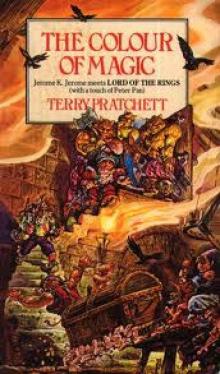 The Colour of Magic
The Colour of Magic Discworld 16 - Soul Music
Discworld 16 - Soul Music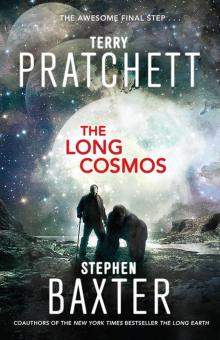 The Long Cosmos
The Long Cosmos The Dark Side of the Sun
The Dark Side of the Sun Monstrous Regiment tds-28
Monstrous Regiment tds-28 The Bromeliad 3 - Wings
The Bromeliad 3 - Wings Dragons at Crumbling Castle: And Other Stories
Dragons at Crumbling Castle: And Other Stories Night Watch tds-27
Night Watch tds-27 The Science of Discworld I tsod-1
The Science of Discworld I tsod-1 The Bromeliad 1 - Truckers
The Bromeliad 1 - Truckers The Science of Discworld Revised Edition
The Science of Discworld Revised Edition The Abominable Snowman
The Abominable Snowman Father Christmas’s Fake Beard
Father Christmas’s Fake Beard The Bromeliad Trilogy
The Bromeliad Trilogy A Slip of the Keyboard
A Slip of the Keyboard The Wee Free Men d(-2
The Wee Free Men d(-2 Johnny and the Dead
Johnny and the Dead Mrs Bradshaw's Handbook (Discworld Novels)
Mrs Bradshaw's Handbook (Discworld Novels) Truckers
Truckers The Amazing Maurice and His Educated Rodents d(-1
The Amazing Maurice and His Educated Rodents d(-1 Diggers
Diggers Thief of Time tds-26
Thief of Time tds-26 Science of Discworld III
Science of Discworld III Dragons at Crumbling Castle
Dragons at Crumbling Castle Nation
Nation Darwin's Watch
Darwin's Watch Interesting Times d-17
Interesting Times d-17 The Bromeliad 2 - Diggers
The Bromeliad 2 - Diggers The Science of Discworld II
The Science of Discworld II